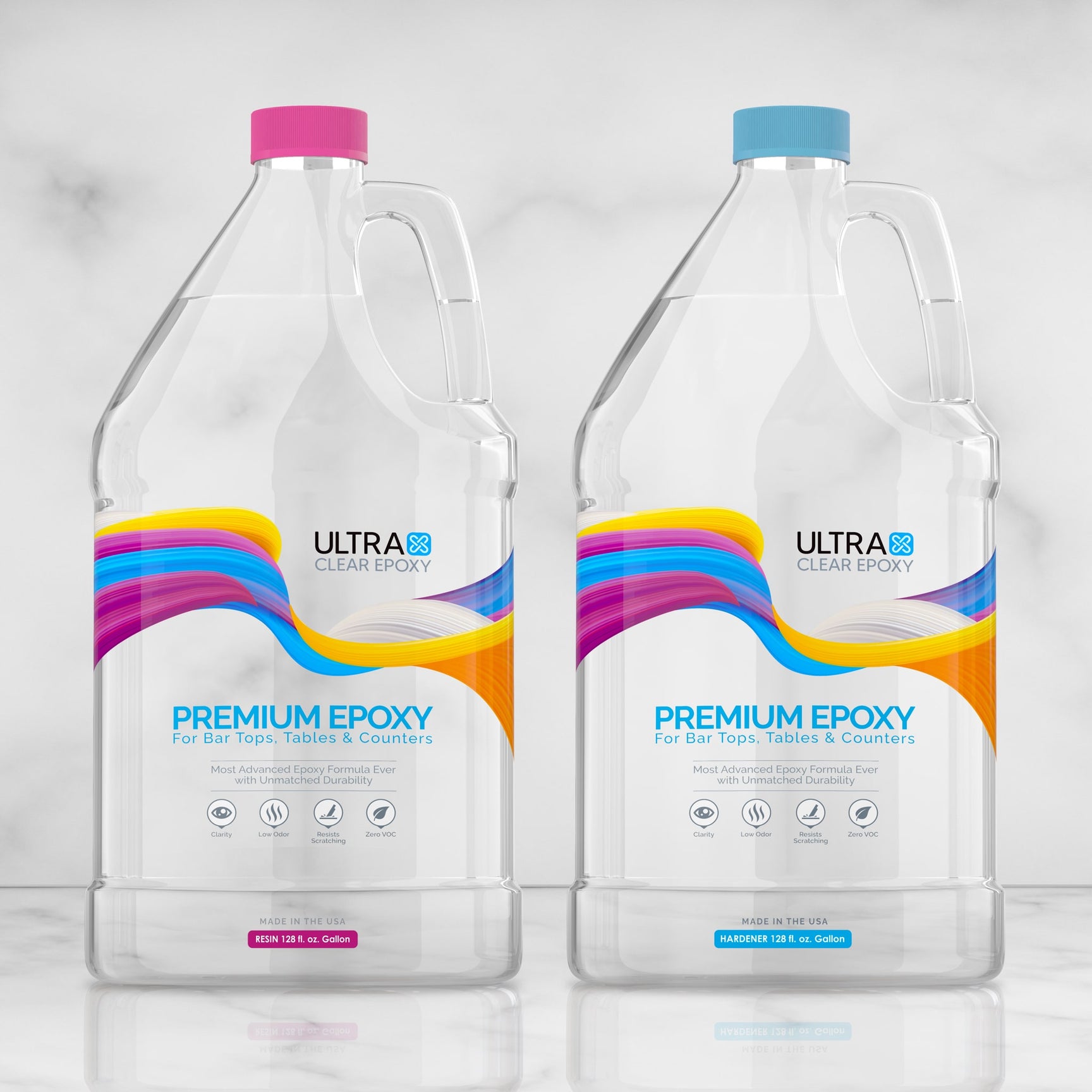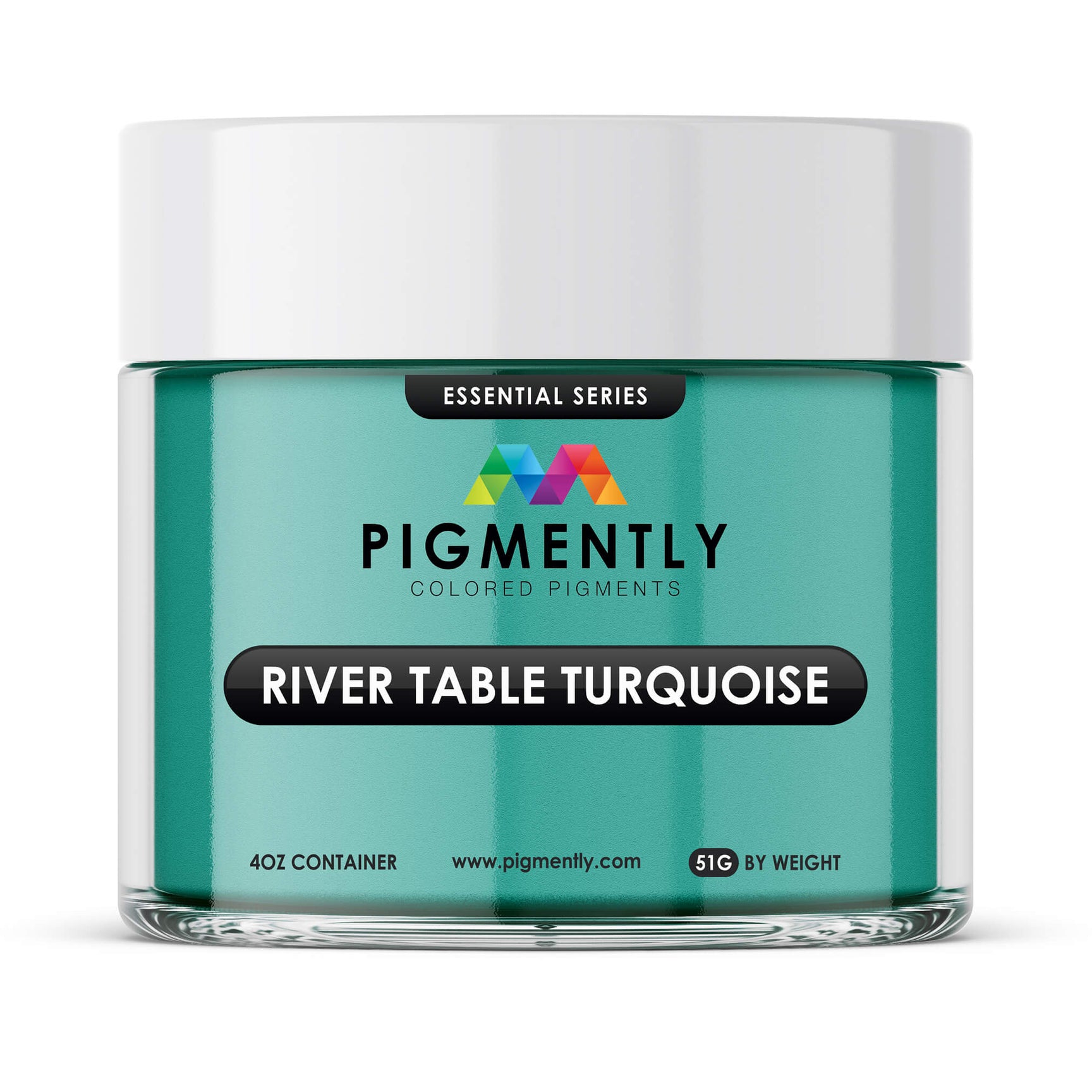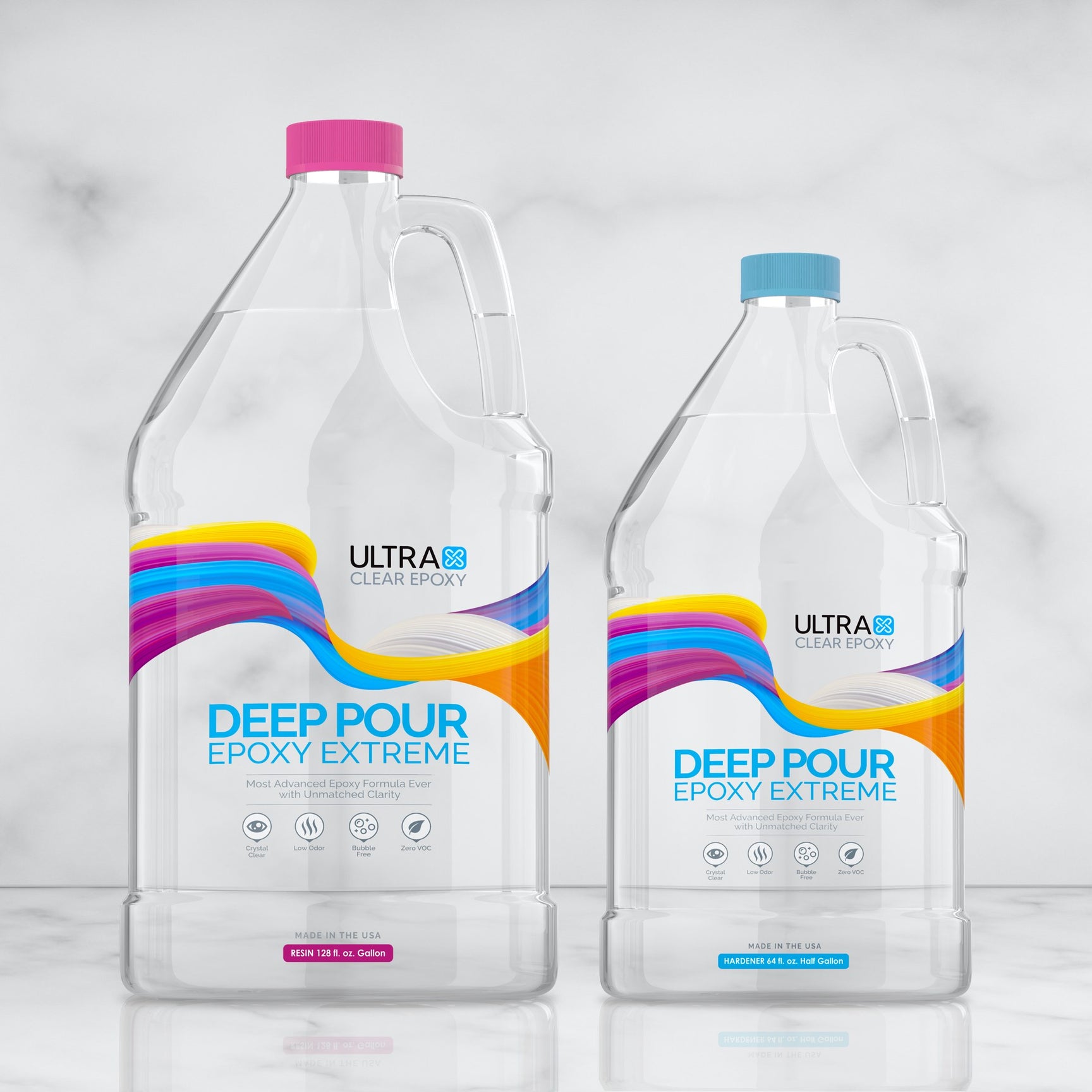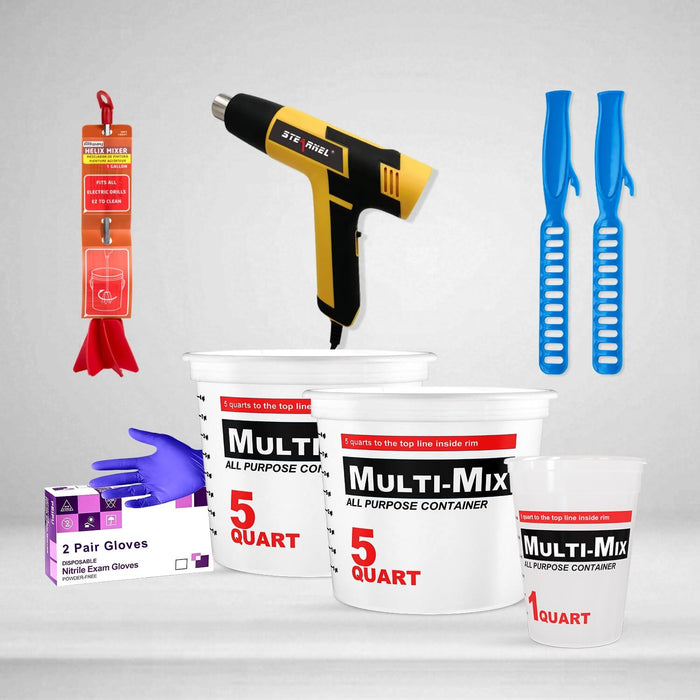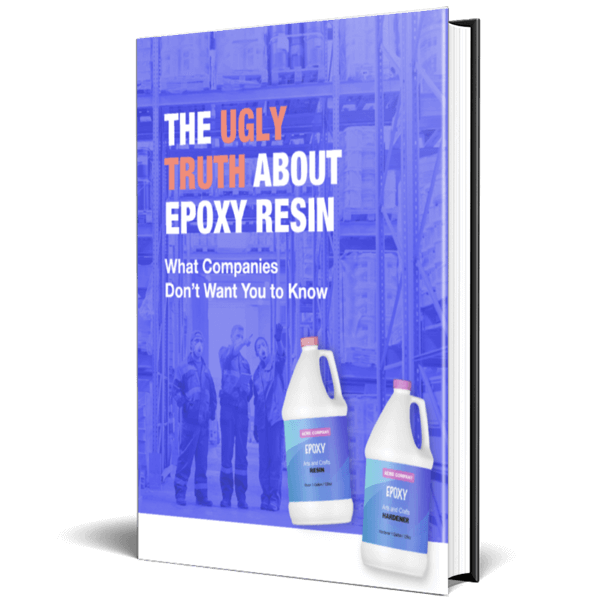Epoxy resin is a thermosetting polymer best known for its strength, ease of use, and resulting transparent finish, once cured. In fact, those are its key selling points: a tough, resilient material that looks attractive like glass.
Yet there's another compelling reason to use epoxy—its ability to absorb pigments and dyes, becoming tinted with different shades and hues. We’ll talk about this pleasing trait below.
What ingredients do you need to add color to epoxy?
There are two common methods to give color to epoxy resin:
- Epoxy powder pigments: These are mica powder pigments which create an irregular pattern that shimmers or is pearlescent by nature. There are many varieties and hues, some of which even glow in the dark.
- Liquid resin dyes: These dyes are able to add a smooth, even tone to the entire epoxy mixture. Use them if you want a singular tone without shimmering effects.
In our store, we offer premium powder pigments and resin dyes from Pigmently.
You can control the intensity/depth of the colors.
The liquid dyes we offer are potent. When you're applying these (or any other) liquid resin dyes, start small. From there, you can mix in more dye, and the tint of the epoxy will gradually become deeper, darker, and more opaque, eventually preventing light from passing through entirely.
The dye's color intensity is one directional, you can't really "undo" the dye if you add too much, so just add a little to your mixture at a time until you’ve attained a satisfying level of color depth and translucency.
Similarly, with mica powder pigments, the more you add, the darker and more intense the shimmering effect will be, while also making the resin appear less translucent. Thus, if you add more and more, at some point you won’t be able to see through the epoxy to what lies within or on the other side as clearly. This isn't a bad thing (many people prefer this look); it's just something to be aware of.
You can limit how strong the powder pigment effects are by starting with a small amount of any pigment, then slowly adding more until you find a ratio that appeals to you.

Bring multiple shades to your project with epoxy powder pigments.
With epoxy, you're not limited to just one pigment per project. Multiple powder pigments can complement each other.
To employ this technique, mix each pigment into its own resin batch. If you want to apply different color batches simultaneously, you'll need to account for the epoxy resin's working time. You don't want to have an older batch that starts curing before you've poured it.
The easiest way to handle this is to have multiple people involved, with each person measuring, then coloring, then mixing up one of the batches to be simultaneously poured.
From there, you can pour the batches as desired. Pouring multiple tinted batches at once onto a substrate (e.g., a wooden table top) will usually cause smooth, graceful color swirls and similar attractive resin patterns to form. The way these patterns look is affected by:
- How you pour the batches - Is one batch being poured faster than others?
- The size of each batch - Is one resin batch different in volume?
- The shape of the substrate - This affects how quickly one section of the substrate fills up as the epoxy self-levels.
For instance, frequent users of epoxy colorants will often make small batches with particular powder pigments that they pour carefully to form deliberate patterns of their own design. By doing this, they treat their project surface like an artist’s canvas, creating a unique visual experience that can’t be replicated precisely—in essence, each piece produced this way is a one-of-a-kind work of art.

Five things to consider before you begin your colorful epoxy project
Before you begin, take a moment to consider the following aspects, as they will influence the end result of your project's appearance.
-
Are you using pigments or dyes?
Powder pigments are made of numerous tiny particles that reflect more light than pure liquid dyes. This makes them a little brighter in well lit environments. -
What effects are you hoping to achieve?
If you want something subtle and uniform, liquid dyes are the way to go.
If you want something eye-catching that stands out, you may prefer to use powder pigments.
It's a good idea to try both types out—if you have the opportunity—and see which you prefer. The more experience you gain with resin dyes and epoxy powder pigments, the greater your understanding will be of how they look in different environments. -
How complex is the appearance you're aiming for?
Remember, epoxy batches will be in a liquid state when you pour them. For example, if you're making a river table with a single deep pour vein, the pouring will be simple—epoxy is self-leveling and will spread into any gaps and grooves on its own, as you fill the "river" space with deep pour resin.
On the other hand, if you want to create more complex patterns or resin imagery, you'll need a way to control how the resin flows and settles. Keep this in mind when planning your project. -
How opaque do you want your colored epoxy to be?
Pigments and dyes are both concentrated. You'll want to use less if you intend to allow light to pass through or simply desire a brighter hue for your epoxy resin.
If your goal is to have a dark color, often the case with black pigments and dyes, you'll end up using more to saturate the epoxy in order to reduce or prevent light from passing through. -
Finally, what will you be pouring your epoxy onto?
Many epoxy projects have a substrate. This is the material (e.g., wood) onto which the epoxy forms a bond.
If your project uses a substrate, think about how dark or light it is, and consider how that will affect the epoxy's color when poured onto it. You may want to use brighter, more vibrant shades if you have a dark substrate to prevent your colors from looking subdued.
Step-by-step instructions on how to color epoxy
Though they serve the same purpose, dyes and pigments are applied in slightly different ways.
We've provided instructions for both types below, starting with epoxy powder pigments.

How to color epoxy with epoxy powder pigments
-
Pour the epoxy hardener component into your mixing container.
Don't add the resin component—that will come later.
Note: Make sure you measure the amount for this batch correctly. For instance, our UltraClear Table Top Epoxy uses a 50:50 ratio, but some other types of epoxy resin require different proportions. Check the instructions included with the epoxy you're working with. -
Add the powder pigment to your hardener.
Start with a small amount at first and add more until you're satisfied with the appearance. Keep in mind that you'll be adding the resin component next, which will dilute the mixture some; you should add a little more to compensate for this.
Ultimately, the amount you add is determined by visual preference. If you'd like a suggestion, however, we recommend 1 gram of powder per 8 ounces of epoxy in your batch. -
Add the resin component and mix the epoxy batch thoroughly.
The epoxy you're using should've included instructions for this part. If you're using an UltraClear Epoxy resin but don't have the instructions anymore, you can find them in our resources section further below. -
Apply the epoxy to your substrate or mold (if you're casting).
This step is pretty straightforward—Just pour your epoxy like normal. Powder pigments won't affect the way it behaves.

How to color epoxy with liquid resin dyes
-
First, add the epoxy hardener component to your mixing container.
Don't add the resin component—that will come later.
Note: Make sure you measure the amount for this batch correctly. For instance, our UltraClear Table Top Epoxy uses a 50:50 ratio, but some other types of epoxy resin require different proportions. Check the instructions included with the epoxy you're working with. -
Begin adding the resin dye to your hardener.
Start with a small amount. Just stir it into the hardener, and keep in mind that when you add the resin component later, the color will lighten and soften as it is diluted due to the increased volume. You should make it a little darker than desired to compensate for this. -
Add the resin component and mix the epoxy batch thoroughly.
The epoxy you're using should've included instructions for this part. If you're using an UltraClear Epoxy resin but don't have the instructions anymore, you can find them in our resources section further below. -
Apply the epoxy to your substrate or mold (if you're casting).
This step is pretty straightforward—Just pour your epoxy like normal. The liquid colorants won't affect the way it behaves.
And that's it! Those are the basic steps for coloring epoxy resin.
By following them, you'll be able to create colorful epoxy batches to pour over substrates or into casting molds, producing visually pleasing art and decorative furniture.
With additional effort, your designs can become more intricate, too. By mixing up smaller epoxy batches of different colors and using your substrate materials to shape and limit where the epoxy flows, you can control the outcome more precisely and make your own beautiful works.

Where can you get reliable powder pigments and resin dyes?
There are numerous pigment and dye brands available on the internet, but many of them are made with lower quality materials and contain fillers. It's a genuine concern, because there's no easy way to vet these products, and it's not uncommon for unscrupulous vendors to pad their ratings with fake review scores.
Because of this, we started offering a premium, high-quality brand of epoxy pigments and dyes directly in our own UltraClear Epoxy store. These dyes and pigments come from Pigmently, and we know they're great because we use them ourselves.
If you don't already have pigments or dyes to use, or if you're simply interested in trying out this recommended brand, you can find them in the Powder Pigment and Liquid Resin Dye sections of our store.
Don't let your hard work go to waste—Watch out for resin scams!
Epoxy colorants can add so much flavor and depth to a resin finish, but for the resin to look as good as it should, it needs to be a quality product.
Sadly, there are many epoxy resin sellers that produce shoddy resin products by cutting corners on quality and safety. These resins look normal at first, but often fail well before their expected lifespan, and are frequently marketed as far more capable than is even possible.
Our free ebook, The Ugly Truth About Epoxy Resin: What Companies Don't Want You to Know, talks about the different ways some resin dealers offload low-quality epoxy onto unsuspecting customers. By reading this book, you'll learn how to avoid dishonest epoxy marketers to save yourself time, money, and prevent a whole lot of stress.Additional resources for this guide
- Table top or deep pour epoxy: Which is right for you? - An article about choosing between table top epoxy and deep pour epoxy.
- UltraClear Table Top Epoxy instructions - Digital instructions for our table top epoxy resin.
- UltraClear Deep Pour Epoxy instructions - Digital instructions for our deep pour epoxy resin.
Have questions? Want advice? Contact us!
If you have any questions about using epoxy powder pigments or resin dyes, please reach out to us at UltraClear Epoxy.
Our epoxy experts are ready to assist, and can provide you with project planning advice, answers to your questions, or help you place an order for whichever supplies you need.
You can contact us via phone or email here. During business hours, you can also text chat online with one of our resin specialists by clicking the Help button at the bottom right of your screen.


